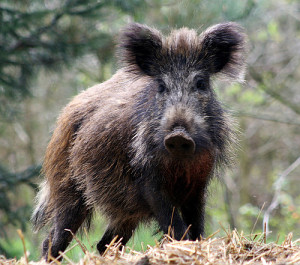
Wild Boar (photo by vlod007)
Six wild boar – donated by the Royal Zoological Society of Scotland’s Highland Wildlife Park at Kincraig near Kingussie – will be used to reduce bracken in an area of ancient birchwood on the estate, restoring a missing ecological process and facilitating the regeneration of native trees and woodland flowering plants.
Alan Watson Featherstone, Executive Director of Trees for Life, said: “Wild boar are an integral part of the Caledonian Forest, and their presence is crucial to the ecological health and balance of a natural woodland. We are very excited to be bringing them to Dundreggan, as they will play a key role in the restoration of the forest there.”
Trees for Life will build on the experience of the 2004-2007 Guisachan Wild Boar Project based on the edge of the Glen Affric National Nature Reserve. That project, in which the charity was a partner, demonstrated the importance of wild boar in forest ecosystems.
Ecologist Liz Balharry, who coordinated the Guisachan Wild Boar Project and is advising Trees for Life, said: “Wild boar are outstanding ecological engineers. Their return to Dundreggan will utilise the knowledge gained by my project and is exciting news for forest restoration in Scotland.”
The ancient birchwood on Dundreggan, like many woodlands in the Highlands, contains an excessive growth of bracken, which shades out flowering plants, inhibiting the regeneration of trees and creating a dense and impenetrable understorey.
Bracken grows rapidly through underground runners called rhizomes. Because its fronds are toxic to most animals, it is often ungrazed and so spreads unchecked. Boar provide a natural control by eating both the rhizomes and fronds. By rooting and exposing the soil, they also create an excellent seedbed for the germination of trees and other woodland plants.
The project will focus on a 12.3 hectare (30.4 acre) area, with the boar confined inside a secure enclosure. Volunteers on Trees for Life’s Conservation Volunteer Weeks will help to monitor the boar’s effectiveness in reducing bracken, and the project will form part of an educational experience for visitors, including school groups.
